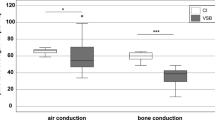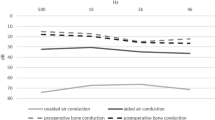Abstract
Purpose
To identify audiological and demographic variables that predict speech recognition abilities in patients with bilateral microtia who underwent Bonebridge (BB) implantation.
Methods
Fifty patients with bilateral microtia and bilateral conductive hearing loss (CHL) who underwent BB implantation were included. Demographic data, preoperative hearing aid use experience, and audiological outcomes (including pure-tone hearing threshold, sound field hearing threshold [SFHT], and speech recognition ability) for each participant were obtained. The Chinese-Mandarin Speech Test Materials were used to test speech recognition ability. The word recognition score (WRS) of disyllabic words at 65 dB SPL signals was measured before and after BB implantation in quiet and noisy conditions.
Results
The mean preoperative WRS under quiet and noisy conditions was 10.44 ± 12.73% and 5.90 ± 8.76%, which was significantly improved to 86.38 ± 9.03% and 80.70 ± 11.34%, respectively, following BB fitting. Multiple linear regression analysis revealed that lower preoperative SFHT suggested higher preoperative WRS under both quiet and noisy conditions. Higher age at implantation predicted higher preoperative WRS under quiet conditions. Furthermore, patients with more preoperative hearing aid experience and lower postoperative SFHT were more likely to have higher postoperative WRS under both quiet and noisy testing conditions.
Conclusions
This study represents the first attempt to identify predictors of preoperative and postoperative speech recognition abilities in patients with bilateral microtia with BB implantation. These findings emphasize that early hearing intervention before implantation surgery, combined with appropriate postoperative fitting, contributes to optimal benefits in terms of postoperative speech recognition ability.




Similar content being viewed by others
Availability of data and materials
Not applicable.
Abbreviations
- BB:
-
Bonebridge
- CHL:
-
Conductive hearing loss
- BCDs:
-
Bone conduction devices
- BCIs:
-
Bone conduction implants
- BHCAs:
-
Bone conduction hearing aids
- AP:
-
Audio processor
- BC-FMT:
-
Floating-mass transducer
- PTA:
-
Pure-tone average
- BC:
-
Bone conduction
- AC:
-
Air conduction
- SFHT:
-
Sound field hearing thresholds
- FHG:
-
Functional hearing gain
- WRS:
-
Word recognition scores
- ANOVA:
-
One-way analysis of variance
- SD:
-
Standard deviation
References
Luquetti DV, Heike CL, Hing AV et al (2012) Microtia: epidemiology and genetics. Am J Med Genet A 158a(1):124–139. https://doi.org/10.1002/ajmg.a.34352
Alasti F, Van Camp G (2009) Genetics of microtia and associated syndromes. J Med Genet 46(6):361–369. https://doi.org/10.1136/jmg.2008.062158
Kelley PE, Scholes MA (2007) Microtia and congenital aural atresia. Otolaryngol Clin N Am 40(1):61–80. https://doi.org/10.1016/j.otc.2006.10.003. (vi)
Zhang L, Gao N, Yin Y et al (2016) Bone conduction hearing in congenital aural atresia. Eur Arch Otorhinolaryngol 273(7):1697–1703. https://doi.org/10.1007/s00405-015-3727-1
Siegert R, Mattheis S, Kasic J (2007) Fully implantable hearing aids in patients with congenital auricular atresia. Laryngoscope 117(2):336–340. https://doi.org/10.1097/MLG.0b013e31802b6561
Thurnheer S, Müller T, Simmen D et al (2022) Congenital aural atresia: hearing rehabilitation using Active Middle Ear Implants. J Laryngol Otol. https://doi.org/10.1017/s0022215122002183
Verhaert N, Fuchsmann C, Tringali S et al (2011) Strategies of active middle ear implants for hearing rehabilitation in congenital aural atresia. Otol Neurotol 32(4):639–645. https://doi.org/10.1097/MAO.0b013e318212023c
Colquitt JL, Jones J, Harris P et al (2011) Bone-anchored hearing aids (BAHAs) for people who are bilaterally deaf: a systematic review and economic evaluation. Health Technol Assess 15(26):1–200. https://doi.org/10.3310/hta15260. (iii–iv)
Choi JE, Ma SM, Park H et al (2019) A comparison between wireless CROS/BiCROS and soft-band BAHA for patients with unilateral hearing loss. PLoS ONE 14(2):e0212503. https://doi.org/10.1371/journal.pone.0212503
Kuthubutheen J, Broadbent C, Marino R et al (2020) The use of a novel, nonsurgical bone conduction hearing aid system for the treatment of conductive hearing Loss. Otol Neurotol 41(7):948–955. https://doi.org/10.1097/mao.0000000000002657
Magliulo G, Turchetta R, Iannella G et al (2015) Sophono Alpha System and subtotal petrosectomy with external auditory canal blind sac closure. Eur Arch Otorhinolaryngol 272(9):2183–2190. https://doi.org/10.1007/s00405-014-3123-2
Iseri M, Orhan KS, Yarıktaş MH et al (2015) Surgical and audiological evaluation of the Baha BA400. J Laryngol Otol 129(1):32–37. https://doi.org/10.1017/s0022215114003284
Tobia A, Yehudai N, Khnifes R et al (2021) Hearing outcomes with percutaneous and transcutaneous BAHA® technology in conductive and mixed hearing loss. Otol Neurotol 42(9):1382–1389. https://doi.org/10.1097/mao.0000000000003231
Ghossaini SN, Roehm PC (2019) Osseointegrated auditory devices: bone-anchored hearing aid and PONTO. Otolaryngol Clin N Am 52(2):243–251. https://doi.org/10.1016/j.otc.2018.11.005
Dun CA, Faber HT, de Wolf MJ et al (2012) Assessment of more than 1,000 implanted percutaneous bone conduction devices: skin reactions and implant survival. Otol Neurotol 33(2):192–198. https://doi.org/10.1097/MAO.0b013e318241c0bf
Shapiro S, Ramadan J, Cassis A (2018) BAHA skin complications in the pediatric population: systematic review with meta-analysis. Otol Neurotol 39(7):865–873. https://doi.org/10.1097/mao.0000000000001877
Kiringoda R, Lustig LR (2013) A meta-analysis of the complications associated with osseointegrated hearing aids. Otol Neurotol 34(5):790–794. https://doi.org/10.1097/MAO.0b013e318291c651
den Besten CA, Monksfield P, Bosman A et al (2019) Audiological and clinical outcomes of a transcutaneous bone conduction hearing implant: six-month results from a multicentre study. Clin Otolaryngol 44(2):144–157. https://doi.org/10.1111/coa.13248
Sprinzl GM, Wolf-Magele A (2016) The Bonebridge bone conduction hearing implant: indication criteria, surgery and a systematic review of the literature. Clin Otolaryngol 41(2):131–143. https://doi.org/10.1111/coa.12484
Riss D, Arnoldner C, Baumgartner WD et al (2014) Indication criteria and outcomes with the Bonebridge transcutaneous bone-conduction implant. Laryngoscope 124(12):2802–2806. https://doi.org/10.1002/lary.24832
Ren R, Zhao S, Wang D et al (2019) Audiological effectiveness of Bonebridge implantation for bilateral congenital malformation of the external and middle ear. Eur Arch Otorhinolaryngol 276(10):2755–2762. https://doi.org/10.1007/s00405-019-05533-2
Fan X, Yang T, Niu X et al (2019) Long-term outcomes of bone conduction hearing implants in patients with bilateral microtia-atresia. Otol Neurotol 40(8):998–1005. https://doi.org/10.1097/mao.0000000000002370
Yang J, Chen P, Zhao C et al (2020) Audiological and subjective outcomes of 100 implanted transcutaneous bone conduction devices and preoperative bone conduction hearing aids in patients with bilateral microtia-atresia. Acta Otolaryngol 140(8):675–681. https://doi.org/10.1080/00016489.2020.1762929
Volgger V, Schießler IT, Müller J et al (2022) Audiological results and subjective benefit of an active transcutaneous bone-conduction device in patients with congenital aural atresia. Eur Arch Otorhinolaryngol 279(5):2345–2352. https://doi.org/10.1007/s00405-021-06938-8
Sprinzl G, Toner J, Koitschev A et al (2023) Multicentric study on surgical information and early safety and performance results with the Bonebridge BCI 602: an active transcutaneous bone conduction hearing implant. Eur Arch Otorhinolaryngol 280(4):1565–1579. https://doi.org/10.1007/s00405-022-07792-y
Cywka KB, Skarzynski PH, Krol B et al (2022) Evaluation of the Bonebridge BCI 602 active bone conductive implant in adults: efficacy and stability of audiological, surgical, and functional outcomes. Eur Arch Otorhinolaryngol 279(7):3525–3534. https://doi.org/10.1007/s00405-022-07265-2
Cywka KB, Skarżyński H, Król B et al (2021) The Bonebridge BCI 602 active transcutaneous bone conduction implant in children: objective and subjective benefits. J Clin Med. https://doi.org/10.3390/jcm10245916
Ratuszniak A, Skarzynski PH, Gos E et al (2019) The Bonebridge implant in older children and adolescents with mixed or conductive hearing loss: audiological outcomes. Int J Pediatr Otorhinolaryngol 118:97–102. https://doi.org/10.1016/j.ijporl.2018.12.026
Jahrsdoerfer RA, Yeakley JW, Aguilar EA et al (1992) Grading system for the selection of patients with congenital aural atresia. Am J Otol 13(1):6–12
Bravo-Torres S, Der-Mussa C, Fuentes-López E (2018) Active transcutaneous bone conduction implant: audiological results in paediatric patients with bilateral microtia associated with external auditory canal atresia. Int J Audiol 57(1):53–60. https://doi.org/10.1080/14992027.2017.1370137
Okada M, Welling DB, Liberman MC et al (2020) Chronic conductive hearing loss is associated with speech intelligibility deficits in patients with normal bone conduction thresholds. Ear Hear 41(3):500–507. https://doi.org/10.1097/aud.0000000000000787
Eroglu S, Cevizci R, Turan Dizdar H et al (2021) Association of conductive hearing loss with the structural changes in the organ of Corti. ORL J Otorhinolaryngol Relat Spec 83(4):272–279. https://doi.org/10.1159/000513871
Buran BN, Sarro EC, Manno FA et al (2014) A sensitive period for the impact of hearing loss on auditory perception. J Neurosci 34(6):2276–2284. https://doi.org/10.1523/jneurosci.0647-13.2014
Zhao H, Wang L, Chen L et al (2018) Temporary conductive hearing loss in early life impairs spatial memory of rats in adulthood. Brain Behav 8(7):e01004. https://doi.org/10.1002/brb3.1004
Gravel JS, Wallace IF, Ruben RJ (1996) Auditory consequences of early mild hearing loss associated with otitis media. Acta Otolaryngol 116(2):219–221. https://doi.org/10.3109/00016489609137827
Yang J, Zhao C, Liu Y et al (2020) The effect of anatomical variables and use of the Lifts system on hearing outcomes after implantation of an active transcutaneous bone conduction device in bilateral congenital conductive hearing loss. J Otolaryngol Head Neck Surg 49(1):57. https://doi.org/10.1186/s40463-020-00452-3
Seiwerth I, Fröhlich L, Schilde S et al (2022) Clinical and functional results after implantation of the bonebridge, a semi-implantable, active transcutaneous bone conduction device, in children and adults. Eur Arch Otorhinolaryngol 279(1):101–113. https://doi.org/10.1007/s00405-021-06626-7
Davidson LS, Geers AE, Uchanski RM et al (2019) Effects of early acoustic hearing on speech perception and language for pediatric cochlear implant recipients. J Speech Lang Hear Res 62(9):3620–3637. https://doi.org/10.1044/2019_jslhr-h-18-0255
Dornhoffer J, Liu YF, Zhao EE et al (2021) Factors that influence second-side cochlear implant speech recognition outcomes. Otol Neurotol 42(3):e279–e285. https://doi.org/10.1097/mao.0000000000002947
Acknowledgements
The authors wish to thank the parents of the children included in this study.
Funding
This study was funded by a grant that Shouqin Zhao received from the Capital Health Research and Development of Special (Grant no. 2020-2-2057).
Author information
Authors and Affiliations
Contributions
YJL and DNW was responsible for the preparation of the manuscript, performing audiological tests. LY performed audiological tests and completed the literature review. PWC analysed the data. JSY prepared and edited of the manuscript. RR and YL coordinated the research clinics to conduct follow-up of the BB cohort. DNW contributed to editing the manuscript and developed the discussion. SQZ was the lead surgeon for all BB cases. The authors read and approved the final manuscript.
Corresponding authors
Ethics declarations
Conflict of interest
The authors declare that they have no competing interests.
Ethics approval and consent to participate
The study design was approved by the medical committee of Tongren Hospital, Capital Medical University (TRECKY2018-067). Written informed consents for participation were obtained from the legal guardians of all participants.
Consent for publication
All study subjects provided informed consent and approved to publish.
Additional information
Publisher's Note
Springer Nature remains neutral with regard to jurisdictional claims in published maps and institutional affiliations.
Rights and permissions
Springer Nature or its licensor (e.g. a society or other partner) holds exclusive rights to this article under a publishing agreement with the author(s) or other rightsholder(s); author self-archiving of the accepted manuscript version of this article is solely governed by the terms of such publishing agreement and applicable law.
About this article
Cite this article
Liu, Y., Yang, L., Chen, P. et al. Role of early hearing aid experience in speech recognition in patients with bilateral congenital microtia following Bonebridge implantation: a retrospective cohort study. Eur Arch Otorhinolaryngol 281, 1205–1214 (2024). https://doi.org/10.1007/s00405-023-08210-7
Received:
Accepted:
Published:
Issue Date:
DOI: https://doi.org/10.1007/s00405-023-08210-7




